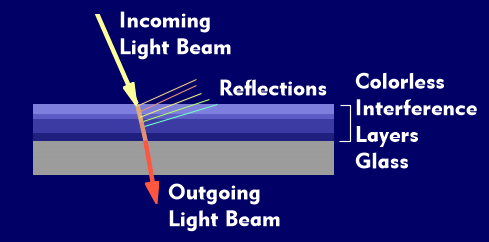interference filter
Since the recording sensors of video cameras, digital cameras and camcorders are only sensitive to brightness, but not to color, the light signals falling on a CMOS sensor or CCD sensor must be separated with color filters and split into the three primary colorsred, green, blue( RGB). This is done with stripe filters, Bayer filters or interference filters, also called color dividing mirrors.
Such interference filters are based on interferences and reflections at the boundary layer between materials with different refractive indices. They consist of colorless transparent layers with thin vapor-deposited interference layers. The layer thicknesses are about one quarter of the wavelength. They allow most of the light to pass and reflect certain wavelengths. Due to the different refractive indices, each individual layer allows a certain wavelength range to pass and reflects another. The individual waves overlap and compensate for each other, creating interference between them, which results in certain wavelengths being emphasized while others are cancelled out.
For example, an interference filter can filter red light and reflect green and blue light. Two interference filters are required to separate white light into the three primary colors and to direct this light to the corresponding CCD sensors.
Interference filters are standardized in ISO standard 9211, which deals with optical layers.

